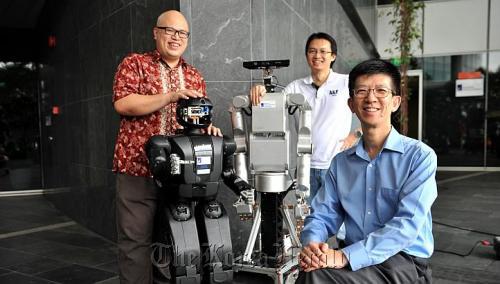As robots are used more by manufacturers here and elsewhere, researchers here are busy building Singapore’s robotics capabilities.
A multi-institute initiative at the Agency for Science, Technology and Research (A*Star) has built robots that can safely work and live side by side with people, learn by watching and even respond to human emotions.
And some inventions, more nimble than conventional industrial automation systems, are already being tested in manufacturing here.
Singaporean Prime Minister Lee Hsien Loong highlighted this trend two weeks ago in a speech at the 80th anniversary dinner of the Singapore Manufacturers’ Federation, when he said: “Robots are becoming more sophisticated and flexible, and rapidly doing work which used to be done by human beings on assembly lines.”
And in a Facebook post last Tuesday, he gave examples of robotics round the world, including a Japanese artificial intelligence system that can pass university entrance exams, and driverless cars developed by Google.
Typically, the robots used in factory automation must be caged as they could injure humans who accidentally get in the way.
 |
Scientists making better robots include (from left) Han Boon Siew with his black robot Hubo, Tee Keng Peng with his Meka Robot, and Li Haizhou, the department head and principal scientist of the Human Language Technology Department, at A*Star’s Institute for Infocomm Research. (The Straits Times) |
But researchers in the A*Star Social Robotics program, which was started in 2008, are working on “smarter” robots.
At the Institute for Infocomm Research (I2R), a large silver robot with arms can be pushed gently out of the way when it encounters obstructions.
And sensors on its hands allow it to detect the shape and consistency of objects it picks up.
“We haven’t tried it with an egg, but that’s the next step,” quipped Dr. Tee Keng Peng, a member of the motion control and learning group in the A*Star Social Robotics program.
And Hubo, a robot developed in collaboration with Korea’s KAIST technology institute, can sense people in its way and approach or walk around them ― and could one day be used as a robotic security guard, for example.
“Right now, we are building capabilities, but going forward we want to use robots for productivity,” said Tan Geok Leng, executive director of I2R.
For instance, they could one day be used to sort recyclable items from garbage, he added.
Currently, differentiating one type of object from another and responding accordingly is difficult for robots, though it is easy for humans.
At the Singapore Institute of Manufacturing Technology (SIMTech), researchers are trying to develop robots that can do just that.
Lim Chee Wang, deputy group manager for mechatronics at SIMTech, explained that some tasks are hazardous, but can be done only by humans at the moment, such as sanding down fast-moving metal parts or machining composite materials that generate lightweight dust.
Most industrial robots today are made to do one task over and over again for a long period, and are “pick-and-place” ones, he said, which cannot gauge the right amount of force to use.
SIMTech has made a module that can be plugged into commercial industrial robots and can make small delicate movements like hand or wrist actions, whereas conventional robotic arms make larger ones like shoulder movements.
By Grace Chua
(The Straits Times)







![[Exclusive] Hyundai Mobis eyes closer ties with BYD](http://res.heraldm.com/phpwas/restmb_idxmake.php?idx=644&simg=/content/image/2024/11/25/20241125050044_0.jpg)
![[Herald Review] 'Gangnam B-Side' combines social realism with masterful suspense, performance](http://res.heraldm.com/phpwas/restmb_idxmake.php?idx=644&simg=/content/image/2024/11/25/20241125050072_0.jpg)